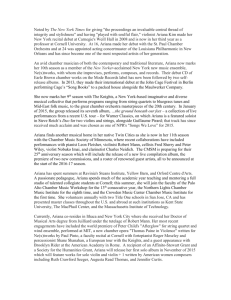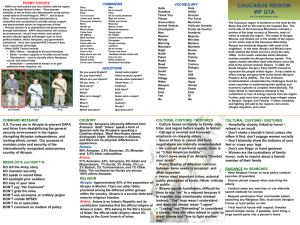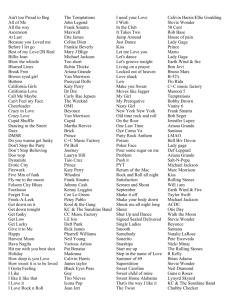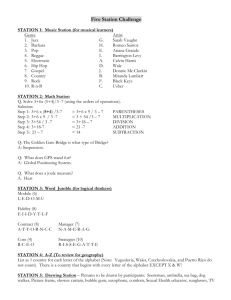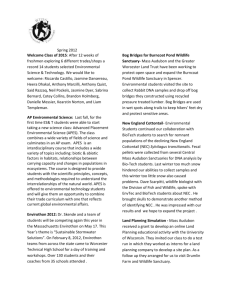Level 1 Home Economics internal assessment
advertisement
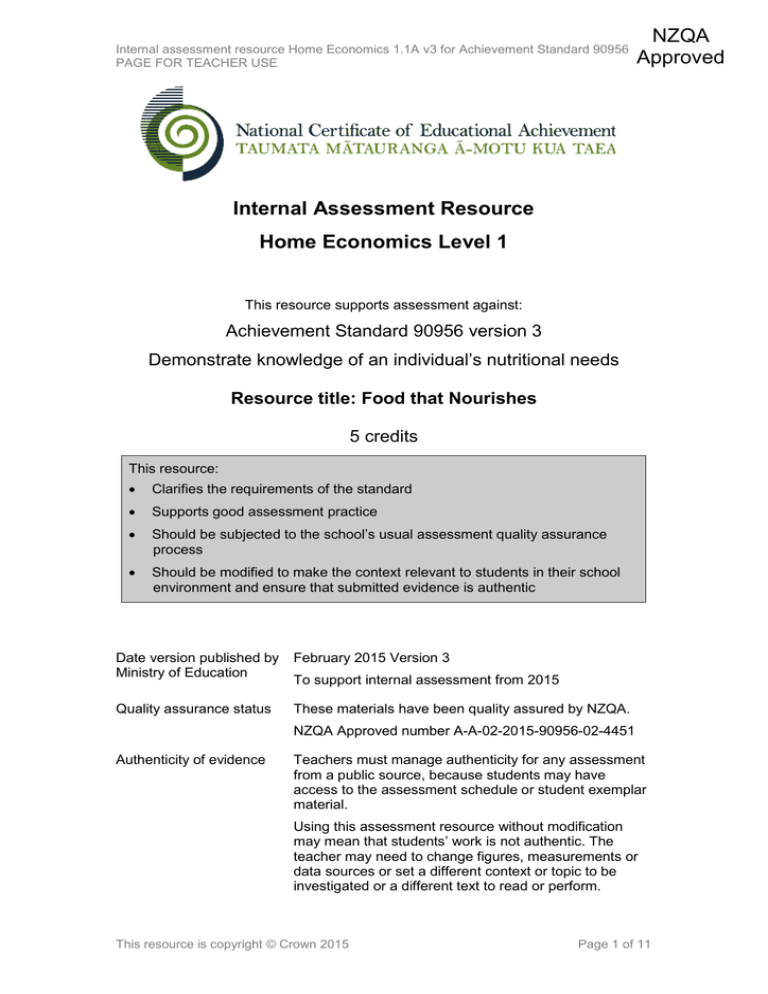
Internal assessment resource Home Economics 1.1A v3 for Achievement Standard 90956 PAGE FOR TEACHER USE NZQA Approved Internal Assessment Resource Home Economics Level 1 This resource supports assessment against: Achievement Standard 90956 version 3 Demonstrate knowledge of an individual’s nutritional needs Resource title: Food that Nourishes 5 credits This resource: Clarifies the requirements of the standard Supports good assessment practice Should be subjected to the school’s usual assessment quality assurance process Should be modified to make the context relevant to students in their school environment and ensure that submitted evidence is authentic Date version published by Ministry of Education February 2015 Version 3 Quality assurance status These materials have been quality assured by NZQA. To support internal assessment from 2015 NZQA Approved number A-A-02-2015-90956-02-4451 Authenticity of evidence Teachers must manage authenticity for any assessment from a public source, because students may have access to the assessment schedule or student exemplar material. Using this assessment resource without modification may mean that students’ work is not authentic. The teacher may need to change figures, measurements or data sources or set a different context or topic to be investigated or a different text to read or perform. This resource is copyright © Crown 2015 Page 1 of 11 Internal assessment resource Home Economics 1.1A v3 for Achievement Standard 90956 PAGE FOR TEACHER USE Internal Assessment Resource Achievement Standard Home Economics 90956: Demonstrate knowledge of an individual’s nutritional needs Resource reference: Home Economics 1.1A v3 Resource title: Food that Nourishes Credits: 5 Teacher guidelines The following guidelines are supplied to ensure that teachers can carry out valid and consistent assessment using this internal assessment resource. Teachers need to be very familiar with the outcome being assessed by Achievement Standard Home Economics 90956. The achievement criteria and the explanatory notes contain information, definitions, and requirements that are crucial when interpreting the standard and assessing students against it. Context/setting This assessment task requires students to demonstrate their knowledge of the nutritional needs of a nominated teenager through the planning, preparation and serving of food. Students will select one of the teenagers as the subject for all parts of the task. Before beginning this activity, provide opportunities for the students to use a range of techniques and processes for the safe and hygienic preparation of food, develop food plans for a range of individuals, and explore the Food and Nutrition Guidelines. Provide a selection of your own recipes for students to choose from, or encourage students to select an appropriate recipe of their own choice. The assessment schedule provides an example of a food plan developed for Ariana, at Achievement level. Use this plan as a guide for interpreting students’ results or you could provide it to students as an example. You will need to change the case study individual and their needs before using this task to ensure authentic responses from students. To demonstrate comprehensive knowledge means that students will justify why the chosen food, liquid and preparation practices meet the nutritional needs of the nominated individual. Conditions Students will work individually to complete the assessment activity under controlled classroom conditions. Students are able to refer to their class notes and any other sources of relevant information. Students will apply their knowledge to the individual in the scenario and their responses will be in their own words. It is suggested that students have at least three hours of in-class time to complete the assessment. Additional time may be required to source recipes and complete planning for the practical assessment. This resource is copyright © Crown 2015 Page 2 of 11 Internal assessment resource Home Economics 1.1A v3 for Achievement Standard 90956 PAGE FOR TEACHER USE Adjust these timings to suit the needs of all your students. It is recommended that no more than eight students be assessed during each practical session to ensure students are given fair and valid practical assessment opportunities. Resource requirements As well as the materials provided in this activity, students will need: access to appropriate classroom resources, for example notes, recipes etc. a range of ingredients access to appropriate facilities to enable the preparation of safe and hygienic food a checklist that both students and the teacher can use to verify the Food and Nutrition Guidelines that students need to follow in the practical work. You should also provide a template to assist students when planning food and liquid for the individual. Use the completed example in the assessment schedule as a model. Additional Information Student Resource A provides some possible questions or a framework that students can use when they are explaining their choices. You can modify these questions to best meet your students’ needs. This resource is copyright © Crown 2015 Page 3 of 11 Internal assessment resource Home Economics 1.1A v3 for Achievement Standard 90956 PAGE FOR STUDENT USE Internal Assessment Resource Achievement Standard Home Economics 90956: Demonstrate knowledge of an individual’s nutritional needs Resource reference: Home Economics 1.1A v3 Resource title: Food that Nourishes Credits: 5 Achievement Demonstrate knowledge of an individual’s nutritional needs. Achievement with Merit Demonstrate in-depth knowledge of an individual’s nutritional needs. Achievement with Excellence Demonstrate comprehensive knowledge of an individual’s nutritional needs. Student instructions Introduction In this assessment activity, you are required to plan, prepare and serve food to meet the nutritional needs of a nominated individual. You will work individually to complete this assessment activity under controlled classroom conditions. You will be able to refer to your class notes and sources of relevant information provided by your teacher. You will apply your knowledge to the individual in the scenario and your responses/answers will be in your own words. There are three parts to this assessment activity: planning food and liquid practical food preparation and service written justification of your choices including foods, liquids and preparation practices. To demonstrate comprehensive knowledge means that you will justify why the chosen food, liquid and preparation practices meet the nutritional needs of the nominated individual. Task Before beginning this assessment activity, read the following case study. Ariana is a 16-year-old high school student. She lives with her parents and 15-yearold brother James. Ariana does not play sport, but she is a keen member of the school band. Once her homework is done, she enjoys spending time either surfing the web, listening to music, practising for band performances or watching television. James, on the other hand, is a keen sportsman. He plays rugby in winter and cricket in summer. To maintain his fitness all year round, he goes for a run several times a week after school. This resource is copyright © Crown 2015 Page 4 of 11 Internal assessment resource Home Economics 1.1A v3 for Achievement Standard 90956 PAGE FOR STUDENT USE Ariana and James are both interested in cooking although they do not have a big range of food preparation skills. Because their parents work long hours, Ariana and James help out by taking turns to prepare the evening meal once or twice a week. They like to cook simple, tasty dishes that use basic ingredients and that do not take too long to prepare. Because the family has a limited budget for food, they make use of low-cost meats and vegetables that are in season. On Fridays, the family enjoys a takeaway meal of fish and chips or pizza. Ariana always jokes that James is able to eat as much as he wants to and he stays thin, whereas she just has to look at food and she gains weight. Choose either Ariana or James as your nominated individual for all parts of the assessment activity. Develop a Food Plan Plan one day’s food and liquid to meet the nutritional needs of your nominated individual. Teacher note: It is recommended that you provide a template for students to help them plan their individual’s food for the day. An example is included in the assessment schedule, which you could adapt into a blank template. Your teacher will provide you with a selection of recipes from which to choose a main meal suitable for your nominated individual. Alternatively, you can select a recipe (or recipes) of your own choice, though you will need to discuss your selection with your teacher. Make sure your plan: meets the specific needs of your nominated individual applies recommendations from the Food and Nutrition Guidelines for healthy teenagers includes a description of all of the meals, snacks, and liquids your nominated individual will consume in one day - include the type and amount of both the food and liquid states serving quantities or volumes of all planned food and liquid includes details of the main meal you will prepare including cooking methods. The main meal needs to: include at least two processes be able to be prepared and served within the allocated time. Prepare, cook and serve your planned main meal Individually prepare, cook and serve the main meal that you planned. You need to complete this work within the allocated time, including cleaning up. Attach a copy of your chosen recipe(s) and your logical order of work to your food plan. Provide a shopping list of your ingredients. This resource is copyright © Crown 2015 Page 5 of 11 Internal assessment resource Home Economics 1.1A v3 for Achievement Standard 90956 PAGE FOR STUDENT USE Justify your Food Plan Explain, using detailed examples, how the planned food and liquid follows the Food and Nutrition Guidelines for healthy teenagers and meets your nominated individual’s nutritional needs. Justify why you made these choices. Consider: the total amount/volume of food and liquids included the type and variety of food and liquids included what and how much was served at the different eating occasions the preparation and cooking practices that were included what nutrients are provided, their function, and their relevance to the individual’s needs. This resource is copyright © Crown 2015 Page 6 of 11 Internal assessment resource Home Economics 1.1A v3 for Achievement Standard 90956 PAGE FOR STUDENT USE Student Resource A: Worksheet Eat many different kinds of foods each day List the breads and cereals in your food plan that meet the Food and Nutrition Guidelines, including the number of serves. - List the fruit and vegetables in your food plan that meet the Food and Nutrition Guidelines, including the number of serves. - Explain why these foods need to be included in your individual’s food plan. List the milk and milk products in your food plan that meet the Food and Nutrition Guidelines, including the number of serves. - Explain why these foods need to be included in your individual’s food plan. Explain why these foods need to be included in your individual’s food plan. List the meat and alternatives in your food plan that meet the Food and Nutrition Guidelines, including the number of serves. - Explain why these foods need to be included in your individual’s food plan. Eat enough for growth and physical activity Identify the foods for growth in your food plan. - Explain why these foods need to be included in your individual’s food plan. Identify the foods that support physical activity in your food plan. - Explain why and when these foods need to be included in your individual’s food plan. Eat the good stuff (choose foods low in fat, sugar and salt) Identify the food choices, preparation practices and cooking methods in your plan that minimise fat, sugar and salt. - Explain why you made these choices and why your nominated individual should follow this guideline. Choose snacks well List the snacks you have included in your food plan. - Explain why you chose these snacks for your nominated individual. Drink plenty every day Identify the liquids in your food plan, including the volume. - Explain why you chose these liquids for your nominated individual. This resource is copyright © Crown 2015 Page 7 of 11 Internal assessment resource Home Economics 1.1A v3 for Achievement Standard 90956 PAGE FOR TEACHER USE Assessment schedule: Home Economics 90956 Food that Nourishes Judgements for Achievement Judgements for Achievement with Merit Judgements for Achievement with Excellence The student demonstrates knowledge of an individual’s nutritional needs. The student: The student demonstrates in-depth knowledge of an individual’s nutritional needs. The student: The student demonstrates comprehensive knowledge of an individual’s nutritional needs. The student: develops a food plan for Ariana or James that meets the recommendations of the Food and Nutrition Guidelines for healthy teenagers and their individual needs prepares, cooks and serves a main meal from their plan. Note: reasons for their food plan choices are not a requirement for Achievement. For example: Food Plan See the Example Food Plan. Ariana’s menu includes: 6 serves bread and cereals (preferably wholegrain) with no extra serves required due to lack of activity 5+ serves fruit and vegetables 3 serves milk and milk products (preferably low fat) 1–2 serves meat (lean) and alternatives 6–8 c liquids (no use of sugary drinks) Some indication of quantities Low fat/salt cooking methods and low fat, salt and sugar ingredients. Specific requirements, extras are restricted due to tendency to gain weight. This resource is copyright © Crown 2015 explains how and why the chosen food and liquid in the food plan meets their nutritional needs. Reasons are linked to a food classification model such as the Food and Nutrition Guidelines, nutrients or the individual’s needs. For example: Eat many different kinds of foods each day Ariana requires at least 2 fruit in her day. I have included unsweetened stewed apple, a banana and a pear. At least 3 vegetables have also been included, e.g. celery, onion, tomatoes, lettuce. Ariana requires the fruit and vegetables as they provide her with carbohydrates for energy, fibre, vitamins and minerals for general good health. Ariana is not active therefore only needs the minimum 6 serves of bread and cereals, e.g. muesli, pita pocket, spaghetti. Some are wholegrain. They will provide Ariana with carbohydrates, fibre and B group vitamins for energy. Ariana requires at least 3 servings of milk and milk products a day, so I have included low-fat milk, cheese and yoghurt. Ariana needs to consume milk products to ensure she receives a good source of calcium for her bone and teeth development. justifies why the chosen food, liquid and preparation practices meet their needs. Reasons include detail on the function of the nutrients and their relevance to the individual’s particular nutritional needs. For example: Eat many different kinds of foods each day Ariana requires at least 2 fruits in her day. I have included unsweetened stewed apple, a banana and a pear. At least 3 vegetables have also been included, e.g. celery, onion, tomatoes and lettuce. Ariana requires fruit and vegetables as they provide her with complex carbohydrates, fibre, vitamins and minerals. They are low in fat, salt and sugar and are an ideal snack. These food choices also provide her body with fibre to prevent constipation. Fibre slows the emptying of the stomach therefore Ariana will feel full for longer. Fruits and vegetables contain water-soluble vitamins like Vitamin C, which is needed for the absorption of iron. Ariana requires a good amount of iron to replace the iron lost in menstruation. Ariana is not active therefore only needs the minimum 6 serves of bread and cereals, e.g. muesli, pita pocket, spaghetti. Some are wholegrain. They will provide Ariana with complex carbohydrates, fibre and B group vitamins for energy. Bread and cereals contain complex carbohydrates, which satisfy hunger for longer as Page 8 of 11 Internal assessment resource Home Economics 1.1A v3 for Achievement Standard 90956 PAGE FOR TEACHER USE Food Preparation Meal includes at least two processes. Food is not heavily salted. Uses low fat cooking methods. Logical order of work is followed to ensure maximum nutrient retention. An appropriate portion is served e.g. Spaghetti Bolognaise: 1c spaghetti, ¾ c meat sauce, 1c salad greens. Ariana requires between 1–2 servings of meat and meat alternatives. I have included lean minced beef for dinner and an egg for lunch, as they provide the body with important sources of protein, iron and other nutrients for growth, repair and maintenance. Eat enough for growth and physical activity Ariana is still growing and therefore her nutrient requirement is high. She is not very active, however; so therefore should keep to the recommended daily servings of each food group to avoid putting on excess weight. Eat the good stuff I have chosen foods low in fat, sugar and salt, e.g. low-fat milk products, untoasted muesli, unsweetened stewed apple, herbs added to the Bolognese sauce and the crackers and popcorn are low-salt varieties. This is to avoid diet- related diseases, such as hypertension or heart disease developing in later life. Choose snacks well Active teenagers need snacks, however, Ariana is not that active, therefore I have planned snacks low in fat, salt and sugar, e.g. popcorn, crisp breads, low-fat cheese. These should stave off hunger pangs without adding to further weight gain. Drink plenty every day Ariana needs to drink at least 6 to 8 glasses every day as she needs to replace the fluids she has lost. Water is the best choice for her as it contains no kilojoules. This resource is copyright © Crown 2015 they take time to digest compared to simple sugars which are quickly absorbed meaning that she will continue to experience hunger. Ariana requires at least 3 servings of milk and milk products a day, so I have included low-fat milk cheese and yoghurt. Ariana needs to consume milk products to ensure she receives a good source of calcium as her bones are still growing, and for them to be strong, she needs calcium. This will also help her to avoid the development of osteoporosis later in life (a thinning of the bones due to a loss of bone mineral, causing bones to fracture easily). This will help her reach peak bone density, essential for future bone health. Ariana requires between 1–2 servings of meat and alternatives. I have included lean minced beef for dinner and an egg for lunch, as they provide the body with important sources of protein and iron. Protein is required for growth, repair and maintenance of all body tissues. Being a teenager, Ariana will need to have plenty of protein to meet her need for growth. Iron forms part of the haemoglobin in red blood cells, which carries oxygen to Ariana’s brain and around her body to promote energy production. Teenagers like Ariana have a heightened need for iron. Eat enough for growth and physical activity Ariana is still growing, and therefore her nutrient requirement is high, though she is not very active and therefore should keep to the recommended daily servings of each food group to avoid putting on excess weight. If hungry, Ariana should eat complex carbohydrates like fruit and salad sandwiches, as they will satisfy her hunger without the extra kilojoules provided from foods like snack noodles, biscuits, cakes and chippies. Page 9 of 11 Internal assessment resource Home Economics 1.1A v3 for Achievement Standard 90956 PAGE FOR TEACHER USE Eat the good stuff The foods chosen are low in fat, sugar and salt, e.g. low-fat milk products, untoasted muesli, and unsweetened stewed apple, herbs added to the Bolognese sauce, and crackers and popcorn are low-salt varieties. This is to avoid the development of eating patterns that may contribute to dietrelated disease later in life. For example, a highsalt diet can lead to hypertension; a high-sugar and fat diet can lead to Type 2 diabetes, some cancers, obesity and heart disease. The low fat choices ensure Ariana still gets fat soluble vitamins such as A needed for normal growth. Choose snacks well Active teenagers need snacks. However, Ariana is not that active, therefore, the snacks planned are low in fat, salt and sugar, e.g. popcorn, crispbreads, low-fat cheese. These should stave off hunger pangs without contributing to further weight gain and also helps to avoid the development of eating patterns that may lead to diet-related diseases later in life. Drink plenty every day Ariana needs to drink at least 6 to 8 glasses every day, as she needs to replace the fluids she has lost. Water is best. Water is required by the body for many functions. It carries substances around the body, e.g. water-soluble vitamins; it is required for all body fluids, e.g. blood, saliva and sweat. Ariana should limit her intake of coke, coffee, tea, etc. as they contain caffeine, causing the kidneys to excrete liquid too quickly from the body and resulting in a loss of nutrients. The sugar content in fizzy also supplies unnecessary kilojoules and may result in tooth decay. Final grades will be decided using professional judgement based on a holistic examination of the evidence provided against the criteria in the Achievement Standard. This resource is copyright © Crown 2015 Page 10 of 11 Internal assessment resource Home Economics 1.1A v3 for Achievement Standard 90956 PAGE FOR TEACHER USE Example Food Plan: Ariana (summer menu) Menu for each meal/snack, with quantities Food group and serving size Extras (“Eat Least” foods) Method of cooking Bread and cereals Fruit and vegetables Milk and milk products Breakfast ½ c muesli, ½ c stewed apple, ¼ c yoghurt & 1 c milk 3 t Milo powder Untoasted muesli (1 s) Unsweetened stewed apple (1 s) Low-fat milk (1 s) Low-fat yoghurt (½ s) 1 c Milo Milo (3 t) Snack 2 crispbread, ½ t Vegemite & 1 slice cheese 1 c water Crispbread (1 s) Low-fat cheese (½ s) 1c water Vegemite (½ t) Lunch 1 egg & 1 c salad & 1 large pita bread pocket 1 pottle strawberry yoghurt 1 banana, 1 c water Wholegrain pita bread pocket (2 s) 1c water Margarine (½ t) Mayonnaise (1 t) Egg: hardboiled 1c water Vinaigrette (1 t) Italian herbs (½ t) Meat: dry-fried Sauce: simmered 1c water Oil (1 t) Popcorn: popped (1 t oil) Snack 1 pear, 1 c water Lettuce (½ s) Carrot (½ s) Banana (1 s) Low-fat yoghurt (1 s) Meat and alternatives Liquid intake Egg (1 s) Pear (1 s) Main meal 1 c spaghetti with ¾ c Bolognese sauce 20 g grated cheese 1 c green salad, 1 c water Spaghetti (1 s) Snack 2 c popcorn, 1 c water Popcorn (1 s) Total servings 6 serves This resource is copyright © Crown 2015 Tomato (1s) Celery & onion in sauce (¼ s of each) Salad greens (1 s) 3 fruit and 4 vegetable serves (Food and method) Apple: stewed in microwave 1c water Low-fat cheese (½ s) 3 ½ serves Lean minced beef (1 s) 2 serves 6 serves Page 11 of 11

